Entrepreneurship and Innovation: Analyzing Firm Size and Innovation
VerifiedAdded on 2023/01/23
|13
|2537
|23
Essay
AI Summary
This essay critically analyzes the statement that small firms are more likely to produce major innovations than large firms. It begins with an introduction to the topic, followed by a discussion of the relative advantages and disadvantages of both small and large firms in fostering innovation. The essay explores factors such as resources, flexibility, market focus, and access to expertise. It examines the impact of firm size on research and development, risk management, and the ability to attract skilled employees. The analysis draws on various research findings to compare the innovation performance of small and large firms, considering both minor and major innovations. The conclusion synthesizes the arguments, providing a nuanced perspective on the relationship between firm size and innovation, and ultimately addresses whether the initial statement holds true. The essay also includes references and an appendix for further information.

Name of the university
Entrepreneurship and innovation
Entrepreneurship and innovation
Paraphrase This Document
Need a fresh take? Get an instant paraphrase of this document with our AI Paraphraser

Contents
Introduction................................................................................................................................1
Findings......................................................................................................................................3
Analysis......................................................................................................................................6
Conclusion..................................................................................................................................6
References..................................................................................................................................8
Appendix....................................................................................................................................8
Introduction................................................................................................................................1
Findings......................................................................................................................................3
Analysis......................................................................................................................................6
Conclusion..................................................................................................................................6
References..................................................................................................................................8
Appendix....................................................................................................................................8
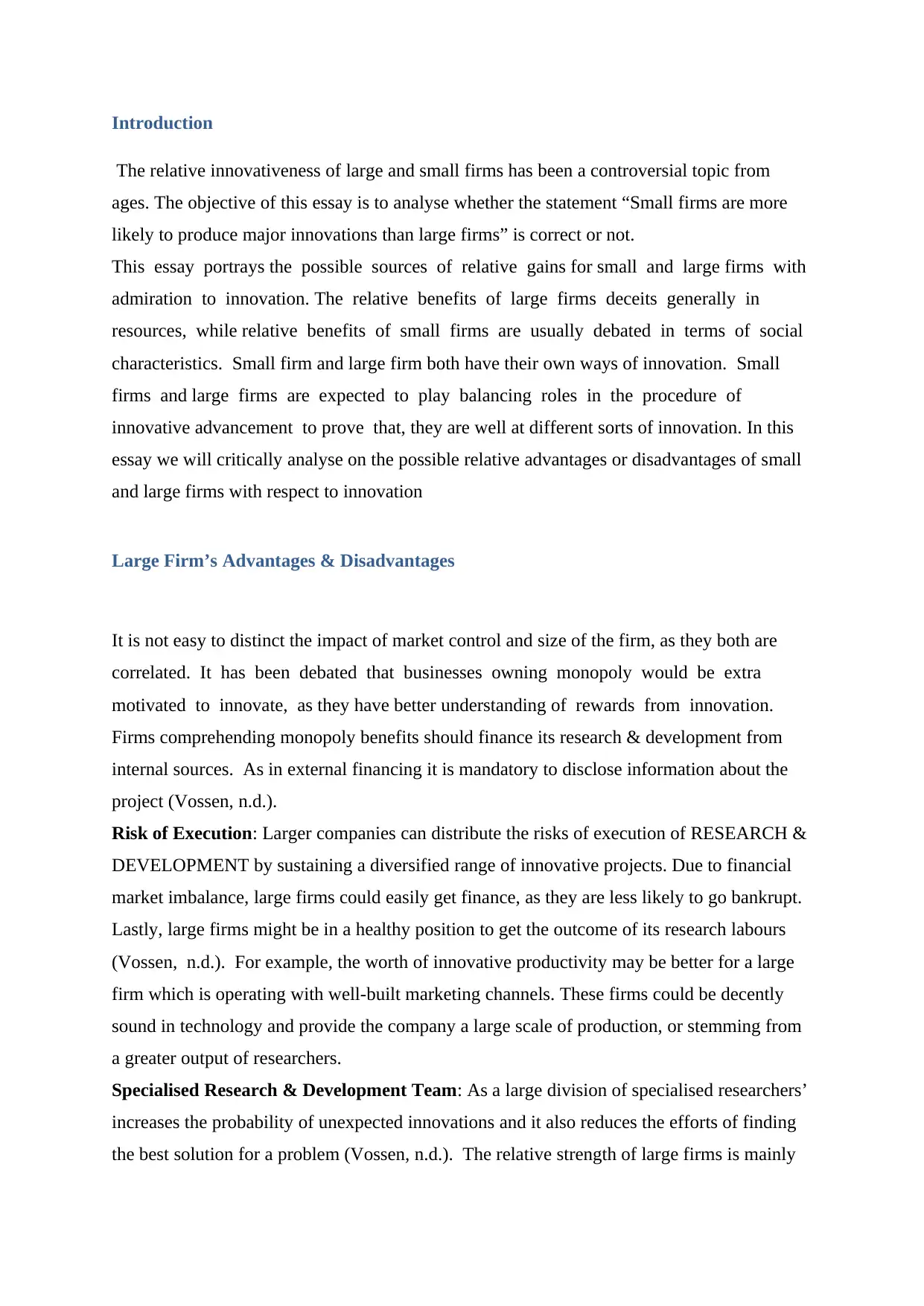
Introduction
The relative innovativeness of large and small firms has been a controversial topic from
ages. The objective of this essay is to analyse whether the statement “Small firms are more
likely to produce major innovations than large firms” is correct or not.
This essay portrays the possible sources of relative gains for small and large firms with
admiration to innovation. The relative benefits of large firms deceits generally in
resources, while relative benefits of small firms are usually debated in terms of social
characteristics. Small firm and large firm both have their own ways of innovation. Small
firms and large firms are expected to play balancing roles in the procedure of
innovative advancement to prove that, they are well at different sorts of innovation. In this
essay we will critically analyse on the possible relative advantages or disadvantages of small
and large firms with respect to innovation
Large Firm’s Advantages & Disadvantages
It is not easy to distinct the impact of market control and size of the firm, as they both are
correlated. It has been debated that businesses owning monopoly would be extra
motivated to innovate, as they have better understanding of rewards from innovation.
Firms comprehending monopoly benefits should finance its research & development from
internal sources. As in external financing it is mandatory to disclose information about the
project (Vossen, n.d.).
Risk of Execution: Larger companies can distribute the risks of execution of RESEARCH &
DEVELOPMENT by sustaining a diversified range of innovative projects. Due to financial
market imbalance, large firms could easily get finance, as they are less likely to go bankrupt.
Lastly, large firms might be in a healthy position to get the outcome of its research labours
(Vossen, n.d.). For example, the worth of innovative productivity may be better for a large
firm which is operating with well-built marketing channels. These firms could be decently
sound in technology and provide the company a large scale of production, or stemming from
a greater output of researchers.
Specialised Research & Development Team: As a large division of specialised researchers’
increases the probability of unexpected innovations and it also reduces the efforts of finding
the best solution for a problem (Vossen, n.d.). The relative strength of large firms is mainly
The relative innovativeness of large and small firms has been a controversial topic from
ages. The objective of this essay is to analyse whether the statement “Small firms are more
likely to produce major innovations than large firms” is correct or not.
This essay portrays the possible sources of relative gains for small and large firms with
admiration to innovation. The relative benefits of large firms deceits generally in
resources, while relative benefits of small firms are usually debated in terms of social
characteristics. Small firm and large firm both have their own ways of innovation. Small
firms and large firms are expected to play balancing roles in the procedure of
innovative advancement to prove that, they are well at different sorts of innovation. In this
essay we will critically analyse on the possible relative advantages or disadvantages of small
and large firms with respect to innovation
Large Firm’s Advantages & Disadvantages
It is not easy to distinct the impact of market control and size of the firm, as they both are
correlated. It has been debated that businesses owning monopoly would be extra
motivated to innovate, as they have better understanding of rewards from innovation.
Firms comprehending monopoly benefits should finance its research & development from
internal sources. As in external financing it is mandatory to disclose information about the
project (Vossen, n.d.).
Risk of Execution: Larger companies can distribute the risks of execution of RESEARCH &
DEVELOPMENT by sustaining a diversified range of innovative projects. Due to financial
market imbalance, large firms could easily get finance, as they are less likely to go bankrupt.
Lastly, large firms might be in a healthy position to get the outcome of its research labours
(Vossen, n.d.). For example, the worth of innovative productivity may be better for a large
firm which is operating with well-built marketing channels. These firms could be decently
sound in technology and provide the company a large scale of production, or stemming from
a greater output of researchers.
Specialised Research & Development Team: As a large division of specialised researchers’
increases the probability of unexpected innovations and it also reduces the efforts of finding
the best solution for a problem (Vossen, n.d.). The relative strength of large firms is mainly
⊘ This is a preview!⊘
Do you want full access?
Subscribe today to unlock all pages.

Trusted by 1+ million students worldwide
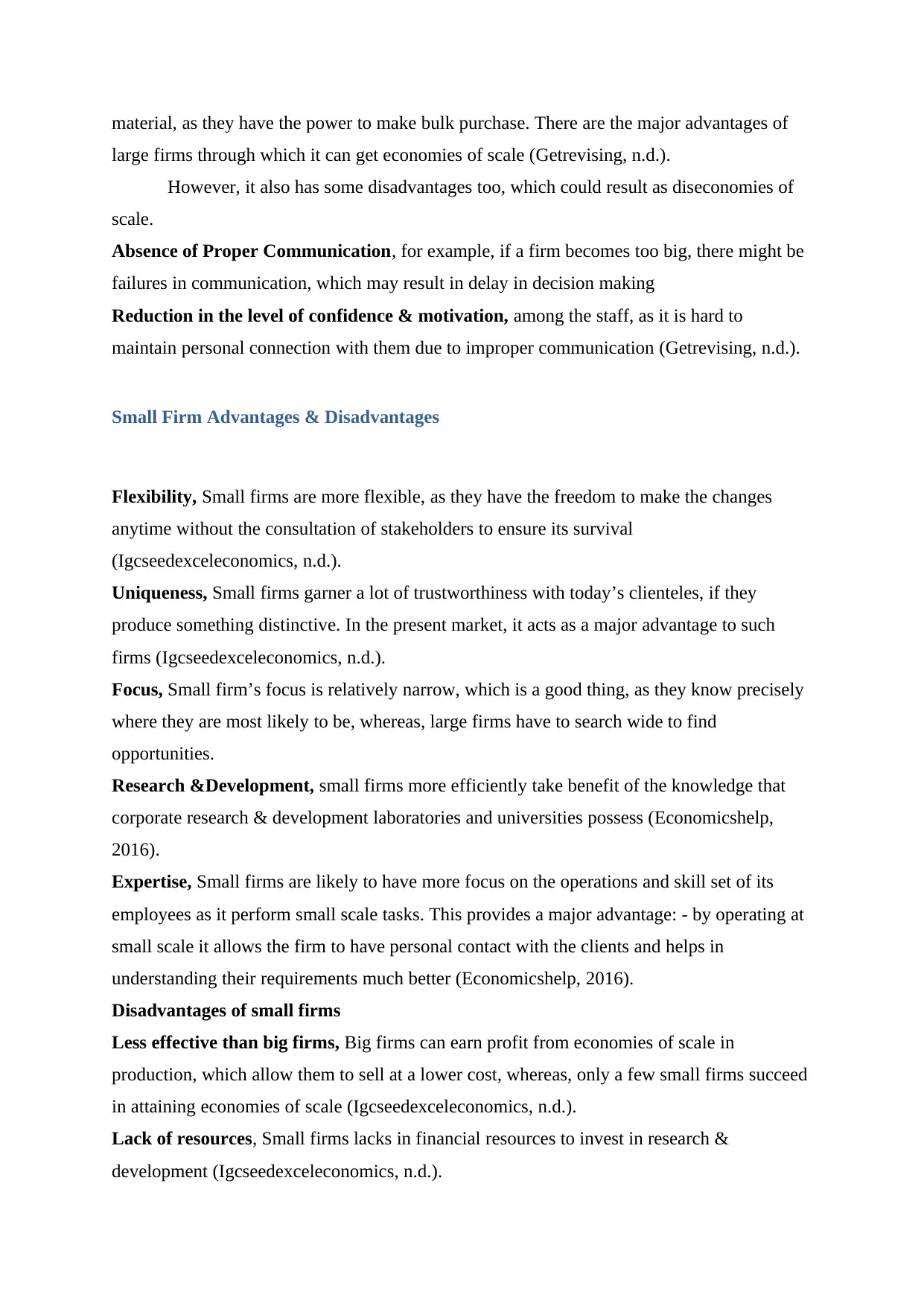
material, as they have the power to make bulk purchase. There are the major advantages of
large firms through which it can get economies of scale (Getrevising, n.d.).
However, it also has some disadvantages too, which could result as diseconomies of
scale.
Absence of Proper Communication, for example, if a firm becomes too big, there might be
failures in communication, which may result in delay in decision making
Reduction in the level of confidence & motivation, among the staff, as it is hard to
maintain personal connection with them due to improper communication (Getrevising, n.d.).
Small Firm Advantages & Disadvantages
Flexibility, Small firms are more flexible, as they have the freedom to make the changes
anytime without the consultation of stakeholders to ensure its survival
(Igcseedexceleconomics, n.d.).
Uniqueness, Small firms garner a lot of trustworthiness with today’s clienteles, if they
produce something distinctive. In the present market, it acts as a major advantage to such
firms (Igcseedexceleconomics, n.d.).
Focus, Small firm’s focus is relatively narrow, which is a good thing, as they know precisely
where they are most likely to be, whereas, large firms have to search wide to find
opportunities.
Research &Development, small firms more efficiently take benefit of the knowledge that
corporate research & development laboratories and universities possess (Economicshelp,
2016).
Expertise, Small firms are likely to have more focus on the operations and skill set of its
employees as it perform small scale tasks. This provides a major advantage: - by operating at
small scale it allows the firm to have personal contact with the clients and helps in
understanding their requirements much better (Economicshelp, 2016).
Disadvantages of small firms
Less effective than big firms, Big firms can earn profit from economies of scale in
production, which allow them to sell at a lower cost, whereas, only a few small firms succeed
in attaining economies of scale (Igcseedexceleconomics, n.d.).
Lack of resources, Small firms lacks in financial resources to invest in research &
development (Igcseedexceleconomics, n.d.).
large firms through which it can get economies of scale (Getrevising, n.d.).
However, it also has some disadvantages too, which could result as diseconomies of
scale.
Absence of Proper Communication, for example, if a firm becomes too big, there might be
failures in communication, which may result in delay in decision making
Reduction in the level of confidence & motivation, among the staff, as it is hard to
maintain personal connection with them due to improper communication (Getrevising, n.d.).
Small Firm Advantages & Disadvantages
Flexibility, Small firms are more flexible, as they have the freedom to make the changes
anytime without the consultation of stakeholders to ensure its survival
(Igcseedexceleconomics, n.d.).
Uniqueness, Small firms garner a lot of trustworthiness with today’s clienteles, if they
produce something distinctive. In the present market, it acts as a major advantage to such
firms (Igcseedexceleconomics, n.d.).
Focus, Small firm’s focus is relatively narrow, which is a good thing, as they know precisely
where they are most likely to be, whereas, large firms have to search wide to find
opportunities.
Research &Development, small firms more efficiently take benefit of the knowledge that
corporate research & development laboratories and universities possess (Economicshelp,
2016).
Expertise, Small firms are likely to have more focus on the operations and skill set of its
employees as it perform small scale tasks. This provides a major advantage: - by operating at
small scale it allows the firm to have personal contact with the clients and helps in
understanding their requirements much better (Economicshelp, 2016).
Disadvantages of small firms
Less effective than big firms, Big firms can earn profit from economies of scale in
production, which allow them to sell at a lower cost, whereas, only a few small firms succeed
in attaining economies of scale (Igcseedexceleconomics, n.d.).
Lack of resources, Small firms lacks in financial resources to invest in research &
development (Igcseedexceleconomics, n.d.).
Paraphrase This Document
Need a fresh take? Get an instant paraphrase of this document with our AI Paraphraser
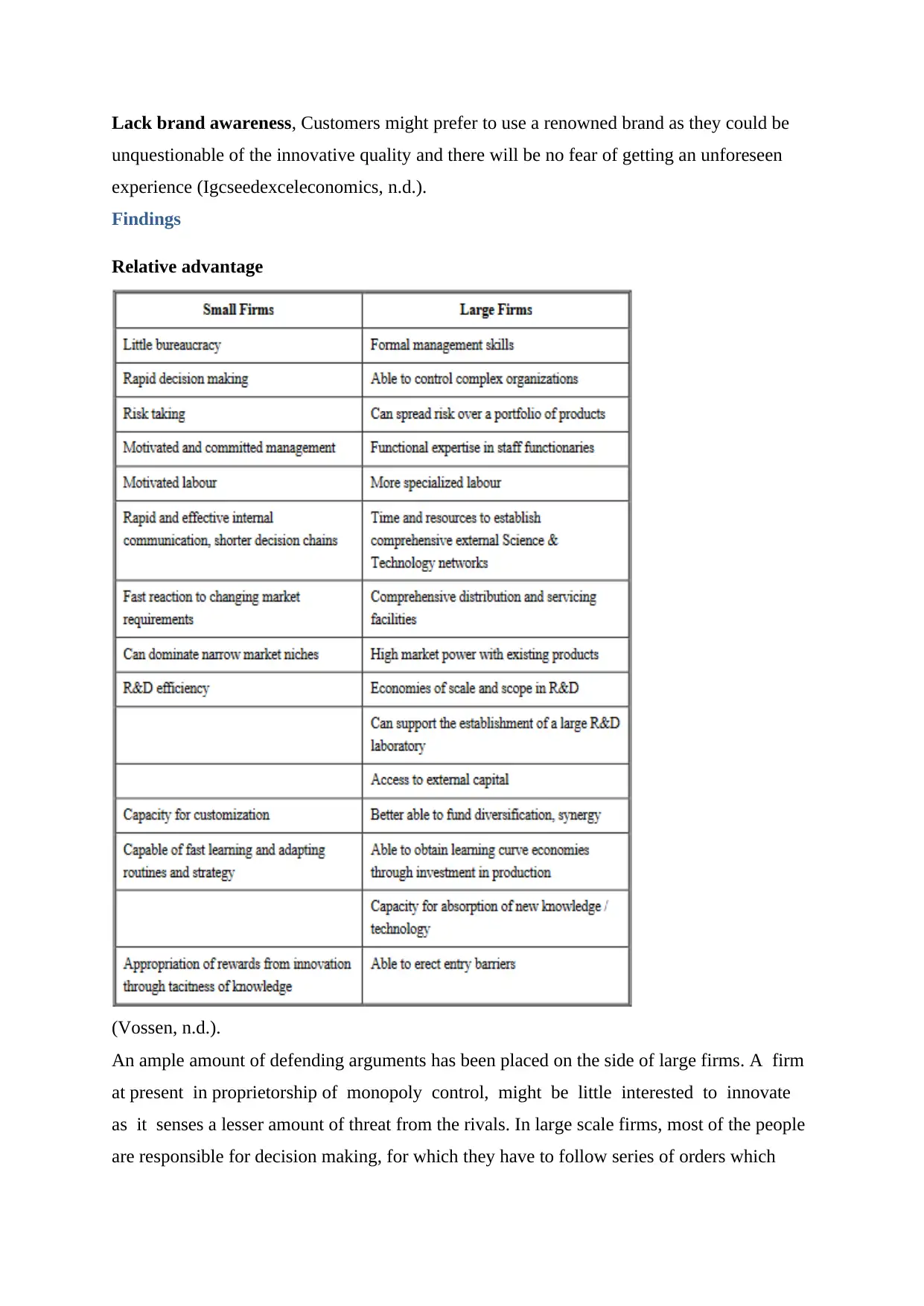
Lack brand awareness, Customers might prefer to use a renowned brand as they could be
unquestionable of the innovative quality and there will be no fear of getting an unforeseen
experience (Igcseedexceleconomics, n.d.).
Findings
Relative advantage
(Vossen, n.d.).
An ample amount of defending arguments has been placed on the side of large firms. A firm
at present in proprietorship of monopoly control, might be little interested to innovate
as it senses a lesser amount of threat from the rivals. In large scale firms, most of the people
are responsible for decision making, for which they have to follow series of orders which
unquestionable of the innovative quality and there will be no fear of getting an unforeseen
experience (Igcseedexceleconomics, n.d.).
Findings
Relative advantage
(Vossen, n.d.).
An ample amount of defending arguments has been placed on the side of large firms. A firm
at present in proprietorship of monopoly control, might be little interested to innovate
as it senses a lesser amount of threat from the rivals. In large scale firms, most of the people
are responsible for decision making, for which they have to follow series of orders which
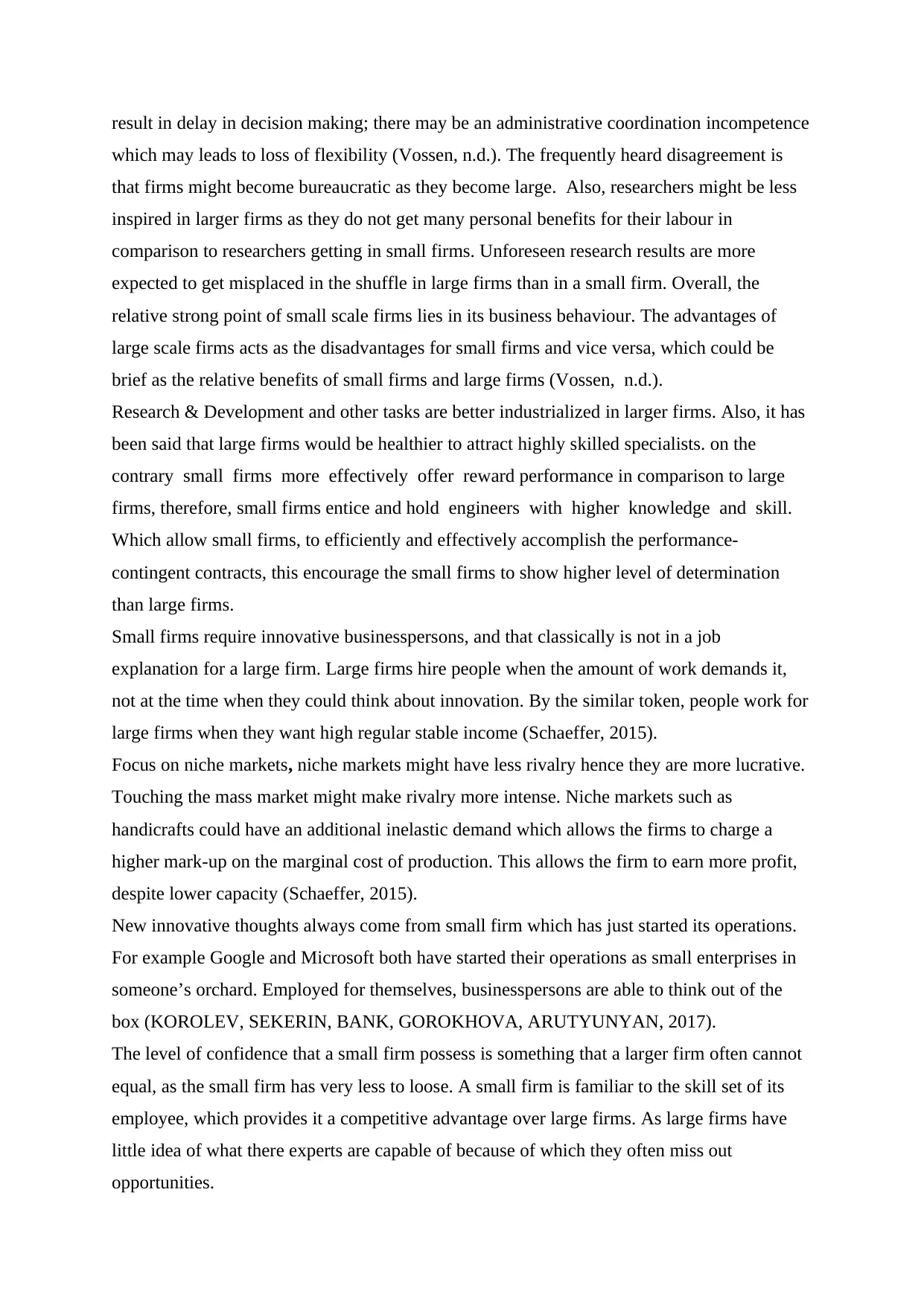
result in delay in decision making; there may be an administrative coordination incompetence
which may leads to loss of flexibility (Vossen, n.d.). The frequently heard disagreement is
that firms might become bureaucratic as they become large. Also, researchers might be less
inspired in larger firms as they do not get many personal benefits for their labour in
comparison to researchers getting in small firms. Unforeseen research results are more
expected to get misplaced in the shuffle in large firms than in a small firm. Overall, the
relative strong point of small scale firms lies in its business behaviour. The advantages of
large scale firms acts as the disadvantages for small firms and vice versa, which could be
brief as the relative benefits of small firms and large firms (Vossen, n.d.).
Research & Development and other tasks are better industrialized in larger firms. Also, it has
been said that large firms would be healthier to attract highly skilled specialists. on the
contrary small firms more effectively offer reward performance in comparison to large
firms, therefore, small firms entice and hold engineers with higher knowledge and skill.
Which allow small firms, to efficiently and effectively accomplish the performance-
contingent contracts, this encourage the small firms to show higher level of determination
than large firms.
Small firms require innovative businesspersons, and that classically is not in a job
explanation for a large firm. Large firms hire people when the amount of work demands it,
not at the time when they could think about innovation. By the similar token, people work for
large firms when they want high regular stable income (Schaeffer, 2015).
Focus on niche markets, niche markets might have less rivalry hence they are more lucrative.
Touching the mass market might make rivalry more intense. Niche markets such as
handicrafts could have an additional inelastic demand which allows the firms to charge a
higher mark-up on the marginal cost of production. This allows the firm to earn more profit,
despite lower capacity (Schaeffer, 2015).
New innovative thoughts always come from small firm which has just started its operations.
For example Google and Microsoft both have started their operations as small enterprises in
someone’s orchard. Employed for themselves, businesspersons are able to think out of the
box (KOROLEV, SEKERIN, BANK, GOROKHOVA, ARUTYUNYAN, 2017).
The level of confidence that a small firm possess is something that a larger firm often cannot
equal, as the small firm has very less to loose. A small firm is familiar to the skill set of its
employee, which provides it a competitive advantage over large firms. As large firms have
little idea of what there experts are capable of because of which they often miss out
opportunities.
which may leads to loss of flexibility (Vossen, n.d.). The frequently heard disagreement is
that firms might become bureaucratic as they become large. Also, researchers might be less
inspired in larger firms as they do not get many personal benefits for their labour in
comparison to researchers getting in small firms. Unforeseen research results are more
expected to get misplaced in the shuffle in large firms than in a small firm. Overall, the
relative strong point of small scale firms lies in its business behaviour. The advantages of
large scale firms acts as the disadvantages for small firms and vice versa, which could be
brief as the relative benefits of small firms and large firms (Vossen, n.d.).
Research & Development and other tasks are better industrialized in larger firms. Also, it has
been said that large firms would be healthier to attract highly skilled specialists. on the
contrary small firms more effectively offer reward performance in comparison to large
firms, therefore, small firms entice and hold engineers with higher knowledge and skill.
Which allow small firms, to efficiently and effectively accomplish the performance-
contingent contracts, this encourage the small firms to show higher level of determination
than large firms.
Small firms require innovative businesspersons, and that classically is not in a job
explanation for a large firm. Large firms hire people when the amount of work demands it,
not at the time when they could think about innovation. By the similar token, people work for
large firms when they want high regular stable income (Schaeffer, 2015).
Focus on niche markets, niche markets might have less rivalry hence they are more lucrative.
Touching the mass market might make rivalry more intense. Niche markets such as
handicrafts could have an additional inelastic demand which allows the firms to charge a
higher mark-up on the marginal cost of production. This allows the firm to earn more profit,
despite lower capacity (Schaeffer, 2015).
New innovative thoughts always come from small firm which has just started its operations.
For example Google and Microsoft both have started their operations as small enterprises in
someone’s orchard. Employed for themselves, businesspersons are able to think out of the
box (KOROLEV, SEKERIN, BANK, GOROKHOVA, ARUTYUNYAN, 2017).
The level of confidence that a small firm possess is something that a larger firm often cannot
equal, as the small firm has very less to loose. A small firm is familiar to the skill set of its
employee, which provides it a competitive advantage over large firms. As large firms have
little idea of what there experts are capable of because of which they often miss out
opportunities.
⊘ This is a preview!⊘
Do you want full access?
Subscribe today to unlock all pages.

Trusted by 1+ million students worldwide
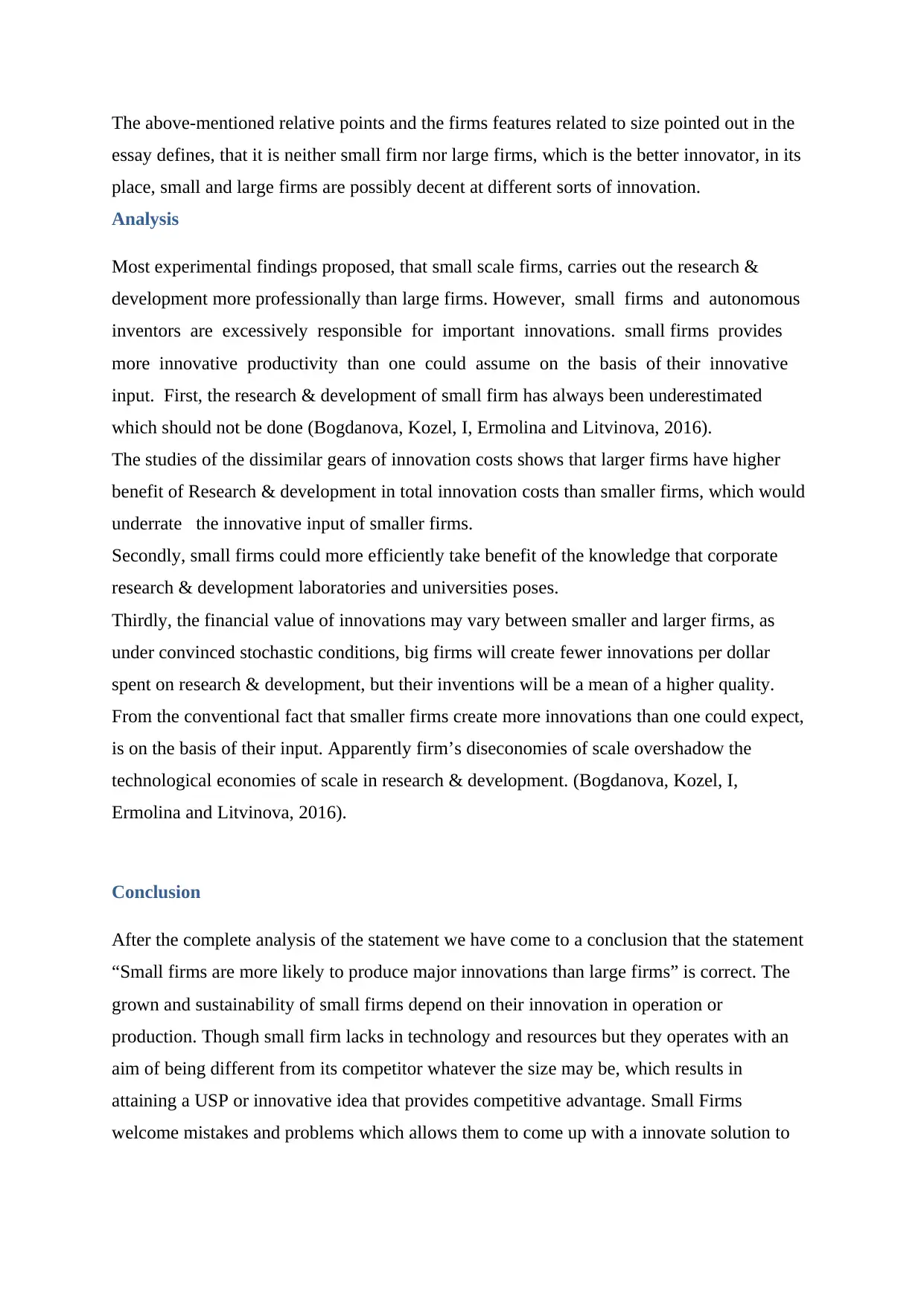
The above-mentioned relative points and the firms features related to size pointed out in the
essay defines, that it is neither small firm nor large firms, which is the better innovator, in its
place, small and large firms are possibly decent at different sorts of innovation.
Analysis
Most experimental findings proposed, that small scale firms, carries out the research &
development more professionally than large firms. However, small firms and autonomous
inventors are excessively responsible for important innovations. small firms provides
more innovative productivity than one could assume on the basis of their innovative
input. First, the research & development of small firm has always been underestimated
which should not be done (Bogdanova, Kozel, I, Ermolina and Litvinova, 2016).
The studies of the dissimilar gears of innovation costs shows that larger firms have higher
benefit of Research & development in total innovation costs than smaller firms, which would
underrate the innovative input of smaller firms.
Secondly, small firms could more efficiently take benefit of the knowledge that corporate
research & development laboratories and universities poses.
Thirdly, the financial value of innovations may vary between smaller and larger firms, as
under convinced stochastic conditions, big firms will create fewer innovations per dollar
spent on research & development, but their inventions will be a mean of a higher quality.
From the conventional fact that smaller firms create more innovations than one could expect,
is on the basis of their input. Apparently firm’s diseconomies of scale overshadow the
technological economies of scale in research & development. (Bogdanova, Kozel, I,
Ermolina and Litvinova, 2016).
Conclusion
After the complete analysis of the statement we have come to a conclusion that the statement
“Small firms are more likely to produce major innovations than large firms” is correct. The
grown and sustainability of small firms depend on their innovation in operation or
production. Though small firm lacks in technology and resources but they operates with an
aim of being different from its competitor whatever the size may be, which results in
attaining a USP or innovative idea that provides competitive advantage. Small Firms
welcome mistakes and problems which allows them to come up with a innovate solution to
essay defines, that it is neither small firm nor large firms, which is the better innovator, in its
place, small and large firms are possibly decent at different sorts of innovation.
Analysis
Most experimental findings proposed, that small scale firms, carries out the research &
development more professionally than large firms. However, small firms and autonomous
inventors are excessively responsible for important innovations. small firms provides
more innovative productivity than one could assume on the basis of their innovative
input. First, the research & development of small firm has always been underestimated
which should not be done (Bogdanova, Kozel, I, Ermolina and Litvinova, 2016).
The studies of the dissimilar gears of innovation costs shows that larger firms have higher
benefit of Research & development in total innovation costs than smaller firms, which would
underrate the innovative input of smaller firms.
Secondly, small firms could more efficiently take benefit of the knowledge that corporate
research & development laboratories and universities poses.
Thirdly, the financial value of innovations may vary between smaller and larger firms, as
under convinced stochastic conditions, big firms will create fewer innovations per dollar
spent on research & development, but their inventions will be a mean of a higher quality.
From the conventional fact that smaller firms create more innovations than one could expect,
is on the basis of their input. Apparently firm’s diseconomies of scale overshadow the
technological economies of scale in research & development. (Bogdanova, Kozel, I,
Ermolina and Litvinova, 2016).
Conclusion
After the complete analysis of the statement we have come to a conclusion that the statement
“Small firms are more likely to produce major innovations than large firms” is correct. The
grown and sustainability of small firms depend on their innovation in operation or
production. Though small firm lacks in technology and resources but they operates with an
aim of being different from its competitor whatever the size may be, which results in
attaining a USP or innovative idea that provides competitive advantage. Small Firms
welcome mistakes and problems which allows them to come up with a innovate solution to
Paraphrase This Document
Need a fresh take? Get an instant paraphrase of this document with our AI Paraphraser

tackle that problem. The example of Google and Microsoft in the essay was enough to define
that small firm are the one that become large with the help of innovation.
that small firm are the one that become large with the help of innovation.
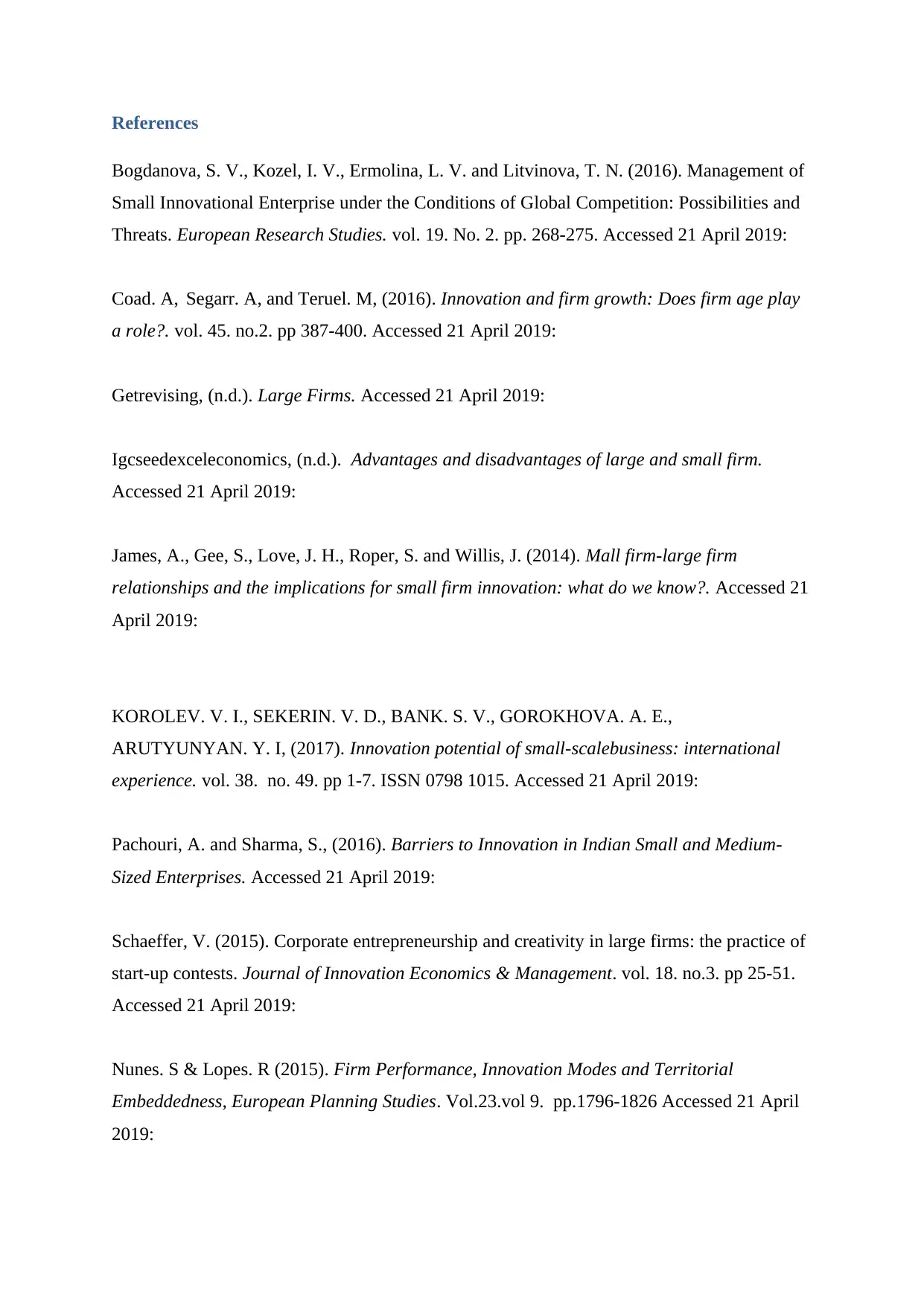
References
Bogdanova, S. V., Kozel, I. V., Ermolina, L. V. and Litvinova, T. N. (2016). Management of
Small Innovational Enterprise under the Conditions of Global Competition: Possibilities and
Threats. European Research Studies. vol. 19. No. 2. pp. 268-275. Accessed 21 April 2019:
Coad. A, Segarr. A, and Teruel. M, (2016). Innovation and firm growth: Does firm age play
a role?. vol. 45. no.2. pp 387-400. Accessed 21 April 2019:
Getrevising, (n.d.). Large Firms. Accessed 21 April 2019:
Igcseedexceleconomics, (n.d.). Advantages and disadvantages of large and small firm.
Accessed 21 April 2019:
James, A., Gee, S., Love, J. H., Roper, S. and Willis, J. (2014). Mall firm-large firm
relationships and the implications for small firm innovation: what do we know?. Accessed 21
April 2019:
KOROLEV. V. I., SEKERIN. V. D., BANK. S. V., GOROKHOVA. A. E.,
ARUTYUNYAN. Y. I, (2017). Innovation potential of small-scalebusiness: international
experience. vol. 38. no. 49. pp 1-7. ISSN 0798 1015. Accessed 21 April 2019:
Pachouri, A. and Sharma, S., (2016). Barriers to Innovation in Indian Small and Medium-
Sized Enterprises. Accessed 21 April 2019:
Schaeffer, V. (2015). Corporate entrepreneurship and creativity in large firms: the practice of
start-up contests. Journal of Innovation Economics & Management. vol. 18. no.3. pp 25-51.
Accessed 21 April 2019:
Nunes. S & Lopes. R (2015). Firm Performance, Innovation Modes and Territorial
Embeddedness, European Planning Studies. Vol.23.vol 9. pp.1796-1826 Accessed 21 April
2019:
Bogdanova, S. V., Kozel, I. V., Ermolina, L. V. and Litvinova, T. N. (2016). Management of
Small Innovational Enterprise under the Conditions of Global Competition: Possibilities and
Threats. European Research Studies. vol. 19. No. 2. pp. 268-275. Accessed 21 April 2019:
Coad. A, Segarr. A, and Teruel. M, (2016). Innovation and firm growth: Does firm age play
a role?. vol. 45. no.2. pp 387-400. Accessed 21 April 2019:
Getrevising, (n.d.). Large Firms. Accessed 21 April 2019:
Igcseedexceleconomics, (n.d.). Advantages and disadvantages of large and small firm.
Accessed 21 April 2019:
James, A., Gee, S., Love, J. H., Roper, S. and Willis, J. (2014). Mall firm-large firm
relationships and the implications for small firm innovation: what do we know?. Accessed 21
April 2019:
KOROLEV. V. I., SEKERIN. V. D., BANK. S. V., GOROKHOVA. A. E.,
ARUTYUNYAN. Y. I, (2017). Innovation potential of small-scalebusiness: international
experience. vol. 38. no. 49. pp 1-7. ISSN 0798 1015. Accessed 21 April 2019:
Pachouri, A. and Sharma, S., (2016). Barriers to Innovation in Indian Small and Medium-
Sized Enterprises. Accessed 21 April 2019:
Schaeffer, V. (2015). Corporate entrepreneurship and creativity in large firms: the practice of
start-up contests. Journal of Innovation Economics & Management. vol. 18. no.3. pp 25-51.
Accessed 21 April 2019:
Nunes. S & Lopes. R (2015). Firm Performance, Innovation Modes and Territorial
Embeddedness, European Planning Studies. Vol.23.vol 9. pp.1796-1826 Accessed 21 April
2019:
⊘ This is a preview!⊘
Do you want full access?
Subscribe today to unlock all pages.

Trusted by 1+ million students worldwide

Vossen, R. W., (n.d.). COMBINING SMALL AND LARGE FIRM ADVANTAGESIN
INNOVATION: THEORY AND EXAMPLES. Accessed 21 April 2019:
INNOVATION: THEORY AND EXAMPLES. Accessed 21 April 2019:
Paraphrase This Document
Need a fresh take? Get an instant paraphrase of this document with our AI Paraphraser

Appendix
Author & year Sector Design
+ sample
Size
Findings Effect
size
Limitation
s
Leve
l
Anshul
Pachouri and
Sankalp
Sharma
(2016)
Banking &
finance
Systematic
review N=
8846
The balance of
operations in
both public and
private research
institutions need
to be improved
for greater reach
and sustenance to
SMEs. Another
main finding is
Transformation
and technology
advancement
sideways with
innovative
approaches of
capacity building
and marketing of
products are
essential
Moderat
e
Limited
relevance
to the
review
question
Alex Coad ,
Agustí Segarra,
MercedesTerue
l (2016)
Spanish
population
Spanish
Communit
y
Innovation
Survey
sample
Those new firms’
express larger
presentation
benefits from
research &
development at
the higher
quintiles of the
Moderat
e
Limited
relevance
to the
review
question
Author & year Sector Design
+ sample
Size
Findings Effect
size
Limitation
s
Leve
l
Anshul
Pachouri and
Sankalp
Sharma
(2016)
Banking &
finance
Systematic
review N=
8846
The balance of
operations in
both public and
private research
institutions need
to be improved
for greater reach
and sustenance to
SMEs. Another
main finding is
Transformation
and technology
advancement
sideways with
innovative
approaches of
capacity building
and marketing of
products are
essential
Moderat
e
Limited
relevance
to the
review
question
Alex Coad ,
Agustí Segarra,
MercedesTerue
l (2016)
Spanish
population
Spanish
Communit
y
Innovation
Survey
sample
Those new firms’
express larger
presentation
benefits from
research &
development at
the higher
quintiles of the
Moderat
e
Limited
relevance
to the
review
question

evolution rate but
faces greater drop
at the lower
quintiles.
RESEARCH &
DEVELOPMEN
T investment by
new companies
act as a major
factor for growth.
Sergio Nunes
(2015)
Portugues
e
population
of firms
N= 397
firms
Our analysis
reflects 3 diverse
modes of
innovation: a DUI
(Doing, Using
and Interacting) ,
STI (Science,
Technology and
Innovation) ,TEI
(Territorial
Embeddedness
Innovation) in
which the key
role is being
played by the
territory. The
innovative modes
are connected in
dissimilar manner
to entities’
economic as well
as innovative act
and additionally
have marked
Moderat
e
Limited
relevance
to the
review
question
faces greater drop
at the lower
quintiles.
RESEARCH &
DEVELOPMEN
T investment by
new companies
act as a major
factor for growth.
Sergio Nunes
(2015)
Portugues
e
population
of firms
N= 397
firms
Our analysis
reflects 3 diverse
modes of
innovation: a DUI
(Doing, Using
and Interacting) ,
STI (Science,
Technology and
Innovation) ,TEI
(Territorial
Embeddedness
Innovation) in
which the key
role is being
played by the
territory. The
innovative modes
are connected in
dissimilar manner
to entities’
economic as well
as innovative act
and additionally
have marked
Moderat
e
Limited
relevance
to the
review
question
⊘ This is a preview!⊘
Do you want full access?
Subscribe today to unlock all pages.

Trusted by 1+ million students worldwide
1 out of 13
Your All-in-One AI-Powered Toolkit for Academic Success.
+13062052269
info@desklib.com
Available 24*7 on WhatsApp / Email
![[object Object]](/_next/static/media/star-bottom.7253800d.svg)
Unlock your academic potential
Copyright © 2020–2025 A2Z Services. All Rights Reserved. Developed and managed by ZUCOL.

